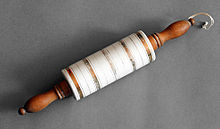Rolling pin
A rolling pin , rolling pin (Austrian), corrugated timber , Wall timber (Swiss) rolling pin , a rolling pin , dough roller , baking roller , cake roll or rolling pin is about 20 to 40 cm long massive roller with a smooth surface for uniform rolling out dough for pasta , Strudel , cakes , cookies and pies is used.
Simple rolling pins such as those used B. in France or China (gǎn-miàn-gùn 擀面 棍) and Japan (menbō 麺 棒) consist only of a four to five centimeter thick round stick, which is rolled with the flat hands over the dough . Common in Germany and the Western world is a variant with almost twice as large diameter and two handles at the ends, either directly from the round bar gedrechselt are or how common today, connected by a shaft about which the roller rotates. Professional corrugated wood, such as B. used in bakeries, have a larger diameter so that the knuckles can no longer hit the table, and they are ball bearings to reduce the friction between the handles and the roller.
Rolling pins are usually made from hard, fine-pored wood such as beech or maple . Rollers that are used in commercial food production are mostly made of marble , plastic or metal .
Importance in popular culture
In the representations of numerous comics and caricatures (e.g. Asterix ) the rolling pin is used by resolute housewives as a kind of baton to discipline disobedient husbands, burglars and others.



